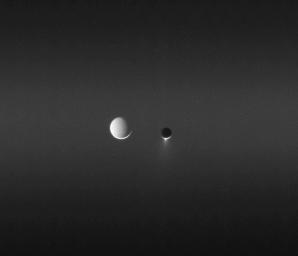Sunlight makes visible the faint band called the E ring as two moons meet in the sky.
Enceladus (505 kilometers, or 314 miles across) and Tethys (1,071 kilometers, or 665 miles across) appear close together in the sky in this image, but in reality, Tethys was more than 260,000 kilometers (162,000 miles) farther from the Cassini spacecraft -- greater than half the distance from Earth to the Moon. Enceladus is easy to identify by the brilliant plume of ice erupting from its south pole.
Although this perspective views the night sides of both moons, the Sun is not the only source of illumination in the Saturn system. Tethys is at a fuller phase with respect to Saturn, and thus its "night side" is more fully lit than that of Enceladus.
The view was acquired from a Sun-Enceladus-spacecraft, or phase, angle of 163 degrees, a viewing geometry in which the microscopic ice particles in its plume brighten substantially.
The image was taken in visible light with the Cassini spacecraft narrow-angle camera on June 6, 2006 at a distance of approximately 3.9 million kilometers (2.4 million miles) from Enceladus and 4.2 million kilometers (2.6 million miles) from Tethys. Image scale is 23 kilometers (14 miles) per pixel on Enceladus and 25 kilometers (16 miles) on Tethys.
The Cassini-Huygens mission is a cooperative project of NASA, the European Space Agency and the Italian Space Agency. The Jet Propulsion Laboratory, a division of the California Institute of Technology in Pasadena, manages the mission for NASA's Science Mission Directorate, Washington, D.C. The Cassini orbiter and its two onboard cameras were designed, developed and assembled at JPL. The imaging operations center is based at the Space Science Institute in Boulder, Colo.
For more information about the Cassini-Huygens mission visit http://saturn.jpl.nasa.gov/home/index.cfm. The Cassini imaging team homepage is at http://ciclops.org.

 Planetary Data System
Planetary Data System












